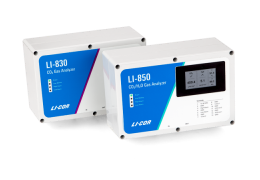Troubleshooting
In this section, we describe how to identify some potential problems. If you can't find a solution here, contact your local distributor or LI-COR technical support for more help.
Instrument will not power on
Power supply adequate? The power supply should source at least 1.2 amps at 12 VDC (minimum of 14 watts during warmup).
Blown fuse? The instrument can be powered from the power jack or pins one and two on the terminal strip. Each connection has its own fuse.
- If you are unable to power on the instrument using the jack, but can power it on using the terminal strip, you probably have a blown power jack fuse.
- If the opposite is true, you probably have a blown terminal strip fuse.
- If you can't power it using either connection, you may have blown both fuses.
Check the resistance across the fuse contacts using an ohm meter. A reading of 0 means that the fuse is good; a reading of 1 indicates that the fuse is blown.
See Replacing a fuse for complete instructions.
Unable to span or zero the instrument
Dirt in the optics? If the optical cell becomes contaminated, the instrument will drift in either the zero or span.
See Cleaning the optical bench for complete instructions.
Instrument reports -50 ppm CO2 or measurements jump around
If the instrument measures -50 ppm or the measurements are going between negative and positive values, or just simply not making any sense, the optical source may have failed or be in the midst of failure. Contact technical support for additional troubleshooting help.
Pump not working
If CO2 and/or H2O do not change as quickly as expected, there might not be adequate flow through the analyzer. This can be from a failed or disabled pump. A simple way to test the pump is to turn it on in the software and exhale near the air inlet. You should see a drastic increase in CO2 concentration within a few seconds. If it takes significantly longer, the pump may not be functioning. You can also check the measured flow rate in the Diagnostics tab of the software. Otherwise, troubleshoot with these steps:
-
Does the gas analyzer have a pump?
-
LI-830 and LI-850 gas analyzers are available with no internal pump. You can check to see if yours has a pump in a few ways: connect to the instrument and check the Diagnostics tab in the software, or you can open the analyzer to physically see if it has a pump installed.
-
Analyzer not warmed up yet?
-
If the heater is enabled, the pump only runs when the optics are warmed up. Make sure that the bench temperature is up to 51 °C. If it never heats up to 51 °C, the optical source or detector may have failed or be on the brink of failure. Contact technical support for additional troubleshooting help.
